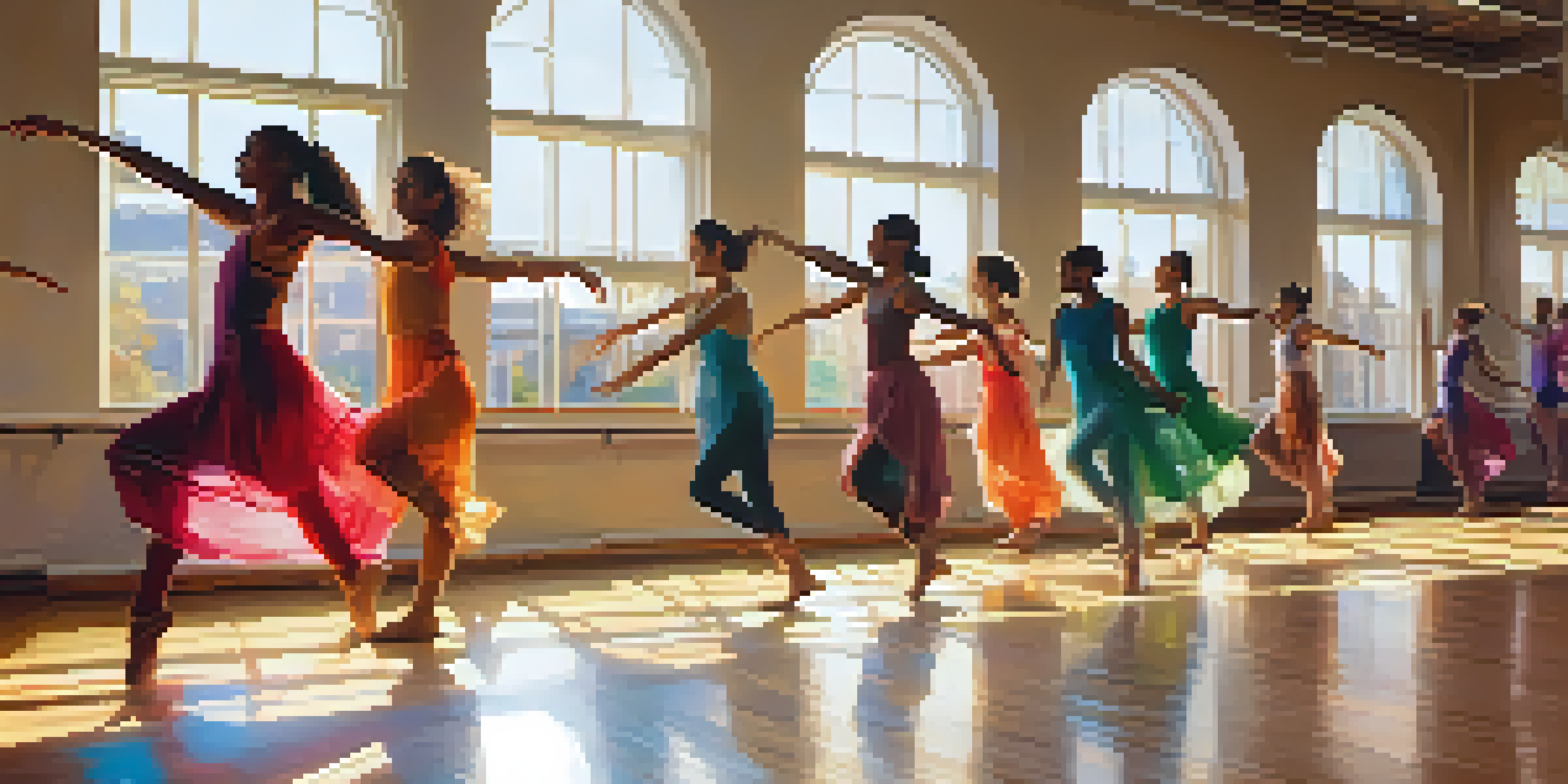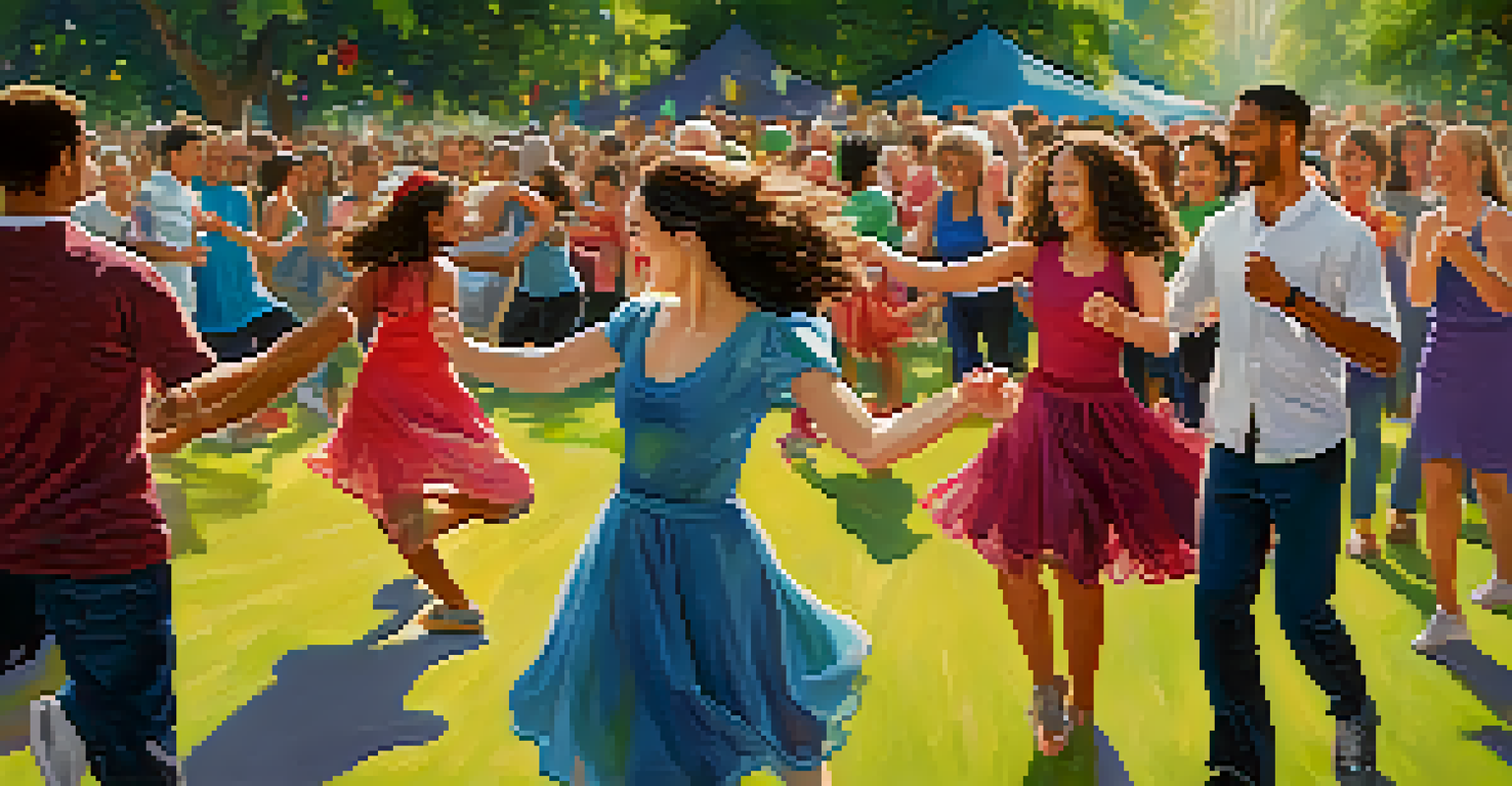The Impact of Dance on Emotional Intelligence and Awareness

Defining Emotional Intelligence and Awareness
Emotional intelligence (EI) is the ability to recognize, understand, and manage our own emotions while also empathizing with others. It's like having a compass that guides us through our interactions and feelings. On the other hand, emotional awareness refers to our capacity to identify and comprehend our emotional states, as well as those of others around us.
Dance is the hidden language of the soul.
These skills are crucial in building healthy relationships, both personally and professionally. Imagine navigating a crowded room; understanding the emotions of those around you can lead to more meaningful connections. This is where dance enters the scene, providing a unique avenue to explore and enhance these capabilities.
Dance, often seen as a form of artistic expression, also serves as a powerful tool for developing EI and emotional awareness. Through movement, individuals not only communicate their feelings but also learn to tune into the emotions of their dance partners, creating a harmonious blend of emotional understanding.
How Dance Facilitates Emotional Expression
One of the most beautiful aspects of dance is its ability to express emotions that words sometimes cannot capture. Whether it's the joy of a lively salsa or the melancholy of a slow waltz, dance allows individuals to channel their feelings through movement. This expression can be liberating, offering a way to release pent-up emotions.

Consider how a dancer might embody sadness through slow, fluid movements or joy through quick, sharp steps. This physical manifestation of emotions not only benefits the dancer but also resonates with the audience, creating a shared emotional experience. This connection can deepen empathy and understanding between individuals.
Dance Enhances Emotional Intelligence
Engaging in dance helps individuals recognize and manage their emotions while also fostering empathy towards others.
By engaging in dance, people can explore various emotional states, thus enhancing their emotional vocabulary. Over time, this practice helps individuals become more attuned to their emotions and the feelings of others, fostering greater emotional intelligence.
The Role of Dance in Building Empathy
Empathy, the ability to understand and share the feelings of another, is a key component of emotional intelligence. Dance provides a unique platform for individuals to practice empathy in real-time. When dancers move together, they must listen and respond to each other's body language, creating a dialogue without words.
The body says what words cannot.
Imagine a pair of dancers intertwined in a duet; their movements are a reflection of their emotional states and mutual understanding. This connection helps develop a deep sense of empathy, as each dancer learns to interpret and respond to the emotional cues of their partner. This practice carries over into everyday life, improving interpersonal relationships.
As dancers become more skilled at reading their partner's emotions, they also enhance their ability to empathize with others outside the dance floor. This translates into better communication and understanding in various aspects of life, whether at work, with friends, or in family dynamics.
Dance as a Tool for Self-Reflection
Engaging in dance can serve as a powerful form of self-reflection. When individuals dance, they often confront their feelings and emotions in a safe environment, allowing for deeper self-exploration. This process can lead to increased emotional awareness, as dancers become more familiar with their internal states.
For example, after a dance session, one might feel a sense of release, clarity, or even confusion about certain emotions. This reflection can prompt individuals to analyze their feelings and understand their triggers, promoting personal growth. The more one dances, the more they can navigate and understand their emotional landscape.
Movement as Emotional Expression
Dance allows for the physical expression of emotions that words often cannot convey, promoting a shared emotional experience.
Ultimately, this practice of self-reflection through dance fosters a greater sense of self-awareness. By recognizing and accepting their emotions, dancers can approach life's challenges with a more grounded and informed perspective.
The Physical Benefits of Dance on Emotion Regulation
Dance isn't just an emotional outlet; it also has physical benefits that contribute to emotional regulation. Engaging in physical activity releases endorphins, which are chemicals in the brain that act as natural mood lifters. This can lead to reduced feelings of anxiety and depression, enhancing overall emotional well-being.
As individuals dance, they move their bodies in ways that can help alleviate stress and tension. This release often translates into a more positive emotional state, making it easier to manage difficult feelings. Picture a dancer lost in the rhythm; the physical engagement can create a sense of freedom that positively influences their emotional state.
In this way, dance becomes a holistic practice, intertwining physical health with emotional stability. By regularly participating in dance, individuals can develop healthier coping mechanisms for dealing with life's ups and downs.
Community and Connection Through Dance
Dance often thrives in community settings, where individuals come together to share their passion for movement. This sense of belonging can significantly enhance emotional intelligence, as social interactions help individuals understand diverse perspectives and emotional experiences. Engaging with a community fosters a supportive environment for emotional growth.
Consider a group dance class where participants encourage each other and celebrate achievements. These social connections promote trust and understanding, allowing individuals to navigate their emotions collectively. The shared experiences can deepen bonds and create a safe space for emotional exploration.
Community Builds Emotional Awareness
Participating in dance within a community enhances emotional intelligence by fostering connections and understanding diverse perspectives.
By participating in dance communities, individuals not only improve their dance skills but also cultivate emotional awareness and empathy. This collective journey can lead to lasting friendships and a heightened sense of belonging, enhancing overall emotional intelligence.
Dance as a Lifelong Practice for Emotional Growth
Incorporating dance into one's life can serve as a continuous journey towards emotional intelligence and awareness. As individuals age, their emotional landscapes evolve, and dance provides a dynamic outlet for exploring these changes. This adaptability is what makes dance a profound practice for emotional growth throughout life.
Whether it's taking up a new dance style or returning to a favorite one, each dance experience presents opportunities for self-discovery and emotional exploration. Just like life's lessons, dance offers new insights and challenges that can be embraced at any age. It's a lifelong companion in the quest for emotional understanding.

Ultimately, the impact of dance on emotional intelligence and awareness is profound. By engaging in this expressive art form, individuals can cultivate vital skills that enhance their relationships and enrich their lives, proving that the dance floor is much more than just a place to move—it's a pathway to emotional growth.